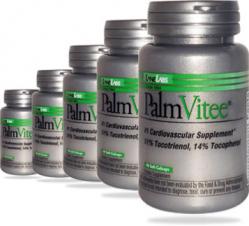Palmvitee - 250 MG - 60 CP
Palmvitte by Lane Labs
Different ratios of these compounds are found in anatomically different parts of a plant. For example, the green parts of a plant contain mostly alpha tocopherol and the seed germ and bran contain mostly tocotrienols.
When this family of compounds was first discovered and determined to be essential for health, a standardized test for its activity was devised for which the members of the family were rated for their biological activity. In one test, alpha tocopherol scored highest and was rated 100% with all others having lower ratings. In accordance with this rating, alpha tocopherol was deemed to be the essential compound and was called vitamin E. One International Unit (IU) of vitamin E activity is the activity under this rating of 1 mg of the plant-derived form of alpha tocopherol.
Since the original rating method was established, many additional important biological effects of these compounds have been discovered and many nutritional scientists now consider that rating method to be incomplete. For example, by the original rating, gamma tocopherol was only 10 to 30% as strong as alpha tocopherol, yet recent studies have shown it to be essential for maintaining the health of cell membranes, especially if alpha tocopherol is being supplemented.
New studies continue to elucidate the unique benefits of individual members of the vitamin E family. For example, tocotrienols have been shown to lower cholesterol, prevent LDL oxidation, and reduce atherosclerotic plaque formation more effectively than tocopherols. For these and other reasons, the original definition of vitamin E has been enhanced to include all eight family members and the related compounds that convert to them in the body.
Vitamin E compounds are usually produced and made available in esterified form as alpha tocopheryl acetate or alpha tocopheryl succinate. Neither of these forms has any antioxidant activity until converted to alpha tocopherol in the body, but they are much more stable with respect to storage time and temperature than the unesterified forms. Moreover, while the acetate form is rapidly activated within the body, activation of the succinate form is slower. The succinate form appears to access and benefit areas of the tissues that are unavailable to the other forms.
For this reason, there is a tendency to regard alpha tocopherol succinate (VES) as a distinctly different and beneficial compound. VES appears to have longer half-life in the body, less effect on blood clotting, and does not interfere with vitamin A and K absorption. It is also more beneficial for cancer therapy according to several published studies.
Serious vitamin takers prefer cold-water dispersible dry powder vitamin E supplements in the form of alpha tocopheryl succinate or acetate because the cold-water dispersible forms are efficiently absorbed even when taken on an empty stomach or with a low-fat meal.
The non-cold water dispersible (oil) forms of vitamin E may be poorly absorbed unless taken with several grams of fats or oils. Cold-water dispersible vitamin E is twice as expensive as soybean oil E-acetate, but the cold-water dispersible forms are more efficiently absorbed. Both acetate” and succinate” vitamin E can come from natural sources.
The importance to the consumer is how well the vitamin E absorbs into the bloodstream. Cold-water dispersible vitamin E, whether in a succinate or acetate form, always comes in a white dry powder, while noncold-water dispersible natural and synthetic acetate forms of vitamin E are always in a thick brown oil.
While 100 IU or more of supplemental vitamin E a day has been shown to reduce the risk of heart attacks in healthy people, those with pre-existing coronary artery disease often take 800 to 1600 IU a day based on the pioneering work of the Shute brothers in the mid 1940s.
One or more members of the vitamin E family may also:
- Maintain cell membrane integrity and reduce cellular aging.
- Inhibit the potentially damaging peroxynitrite radical.
- Inhibit melanoma cell growth in mice.
- Prevent abnormal blood clotting.
- Synergize with vitamin A to protect the lungs against pollutants.
- Protect nervous system and retina.
- Lower the risk of ischemic and coronary heart disease.
- Lower the risk of certain kinds of cancer.
- Protect immune function.
- Reduce the risk of Alzheimer s disease.
Caution:. If you are taking anti-clotting medication, consult with your doctor before taking this product. Ingestion of total vitamin E products in excess of 1200 IU daily may interfere with absorption and metabolism of vitamins A and K. Palm-oil derived tocotrienols contain four different compounds of the vitamin E family that some studies suggest may be as much as 40 times more potent per milligram than standard alpha tocopherol for protecting against elevated cholesterol, LDL oxidation, and atherosclerotic plaque formation.
Many alternative doctors are recommending tocotrienols as a potential cholesterol-lowering nutrient in place of FDA-approved drugs. A recent study showed that mice given tocotrienols survived longer than mice given regular vitamin E.


